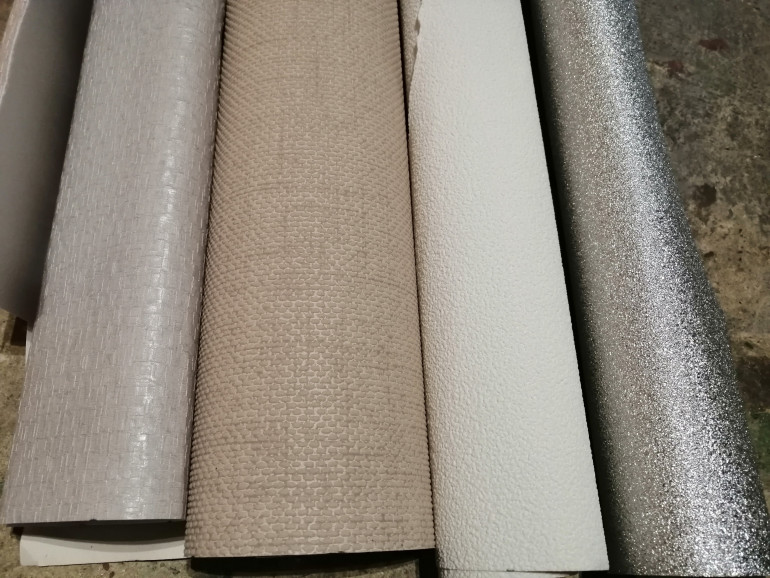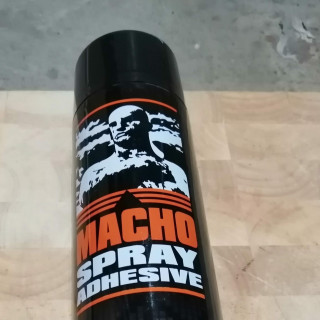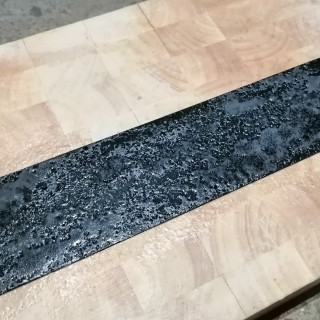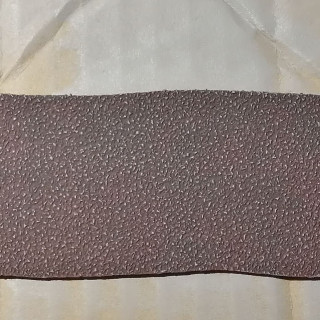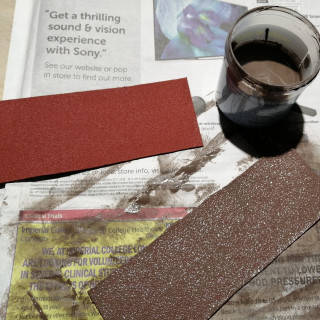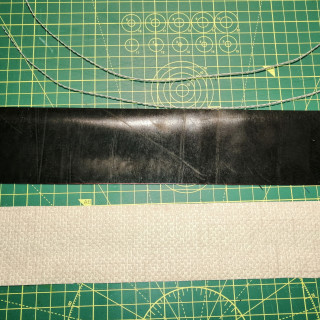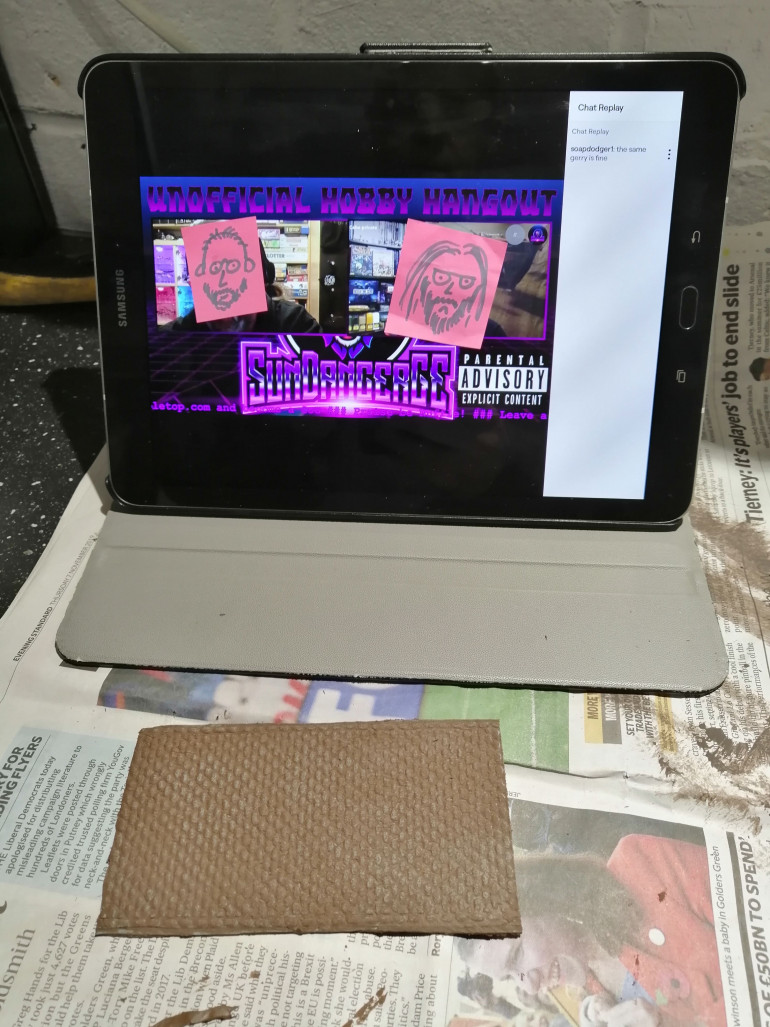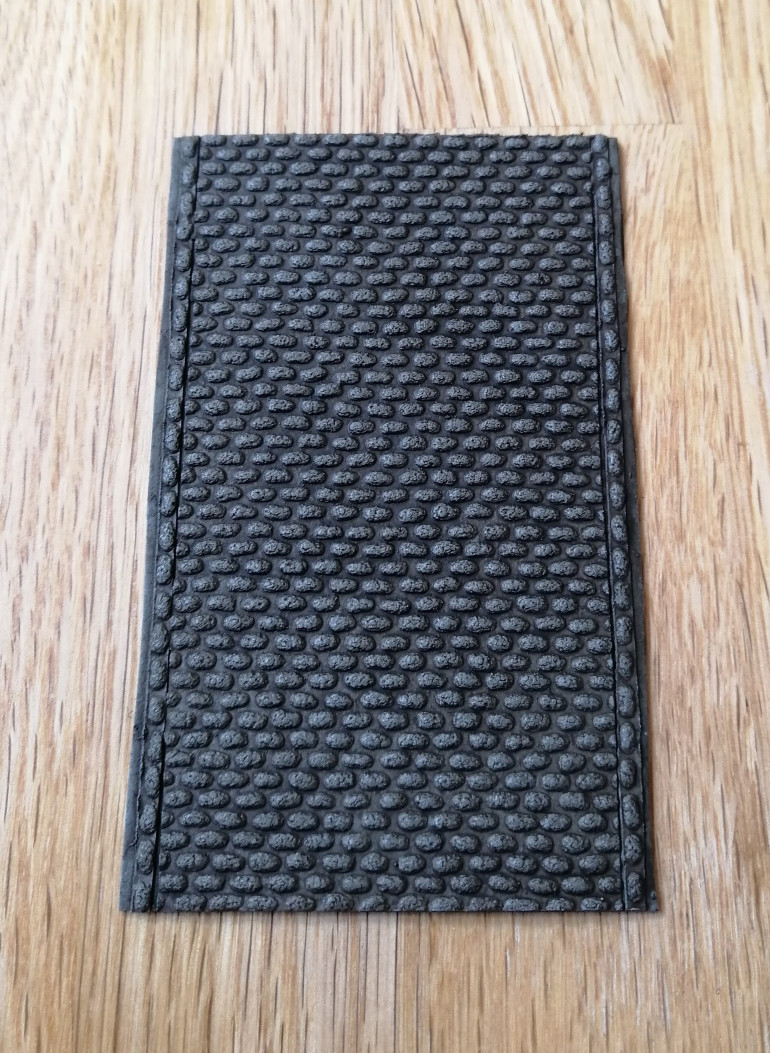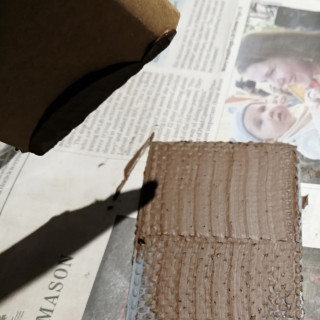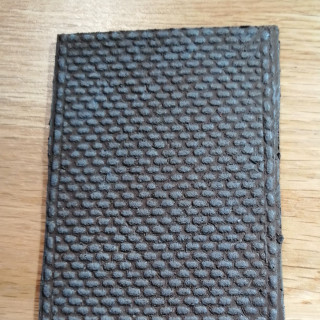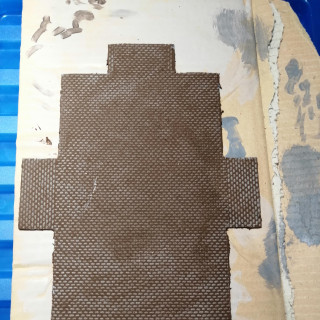
Getting roads to just ruddy lay flat
Recommendations: 552
About the Project
I'd really like to have roads for my war games that actually sit on the contours of the board. It's just more immersive. This project looks at my mistakes in getting to a solution that's cheap and simple
Related Genre: Historical
This Project is Completed
What's the problem?
Some years ago, I made some roads for my war gaming. My first effort was sand paper glued to floor tiles and ‘painted’ up. My second effort was Polyfilla applied to floor tiles and then ‘painted’. As you can see from the photos below, both efforts look pretty shoddy.
What’s more, time has not treated these well. The sandpaper is starting to come away from the floor tile and both types of road are warping, some badly.
So it’s time to do something about it and replace my old roads.
It's all about immersion
I realised a little while ago that I enjoyed my games more when the gaming table looked more realistic. Immersion made the whole experience just more enjoyable. My first step was creating a teddy bear fur gaming mat. This made a huge difference from the green sheet of canvas I was previously using.
I also made some hills that I quickly discovered looked more realistic when placed under the teddy bear fur gaming mat.
In addition to my old roads being old and crap, they’re also rigid. So when you put them on this gently rolling countryside, it just ruins the immersion.
Roads should conform to the contours of the countryside, not do this:
So I’m going to aim to make flexible roads that will sit onto hills and look more natural. I’m also going to try and do this cheaply and with minimum effort.
So I’ll use this project to illustrate what I got wrong and right.
Materials and other options
I’m aware that there are retailers out there selling flexible roads. Some of these look pretty good but they’re not cheap. And I generally find that I need a reasonable selection of curves, straights, junctions and so forth to allow for different table layouts. And as this project is a terrain build, I’m not going to buy anything.
Latex would appear an obvious option as this is flexible and durable. You do however need to cast this and that requires molds to be made. That strikes me as a right pain and I’ve never cast anything in my life. I don’t thing a road complex is really the place to start my casting journey. It’s probably not a cheap option either.
Having recently been forced to do some decorating, I am aware of decorators caulk (or alternatively silicon rubber) that you can get from all good diy stores. It’s also cheap as chips and the acrylic based version can be painted over very easily. So I think the below will come in handy:
Otherwise, as my gaming mat is made from teddy bear fur, this seems a good place to start to see if I can use this to create some roads.
Attempt 1
In hindsight, I’m not entirely sure what I was thinking when I tried this approach. So spoiler alert, this was a complete failure.
Looking at my teddy bear fur gaming mat and seeing its flexible properties, my first thought was to use the off cuts from the mat to make the roads. After all, painted up correctly, it would blend better into the mat and improve the immersion.
Here’s a sample of the fur before I got started with it:
Clearly painting the fur to look like a road would look awful. I somehow thought though that applying a decorator’s caulk mix would look a whole lot better.
To make the mix, I squeezed some caulk into a tub with some brown acrylic paint. In my mind, I was aiming for a dirt road.
On the plus side, the caulk mixed very well. I applied it to the fur using a tongue depressor and sprinkled some sand over the top to try to create some texture. I left it to dry.
Here’s the results:
As you can see, it looks nothing like a dirt road. The caulk got matted into the long fur, clumped and didn’t sit flat. The sand just looks like sand sprinkled on the top.
In hindsight, this result was all very predictable. So we’ll chalk this one down to experience and talk no more about it.
Attempt 2
Taking a look at my first disastrous attempt, I felt that the main problem was that the hair on the dead teddy bear skin was too long. I remedied this by taking my hair clippers to the fur and removing as much of it as I could down to the material. If I leave fur on either side of the where the road will be, I can then colour this green and it will help things blend in.
I once again went with the caulk and brown paint mix but this time added some sand into this mix rather than sprinkling it on top.
Here was the result:
Now this looked promising. The fur on either side of the road is a little long, but this can be easily fixed with a little trim with the clippers. It’s also flexible, which is the main priority. Finally, it looks reasonably realistic as a dirt road, especially as an experiment – with more finesse in the application, a wash and a dry brush, it could look really good.
This, it seems, was the solution to my problem.
And then I spotted this:
Going along the road in closer detail exposed some more cracks, albeit not as bad as the one above.
On inspection, it would seem that the little bit of fur that the clippers could not remove coupled with the very loose weave of the material used as the fur backing meant that the caulk didn’t really adhere fully to the material. It sits a little on top so doesn’t dry and flex with the material.
This is a show stopper but at least the fur down either side of the road looks good.
Attempt 3
I decided to try a closer weave material as the backing for the caulk mix in the hope that this would give something more for the caulk to fix to. I have some canvas lying around which meets these requirements.
Before applying any caulk, I liked the look of the fur border in the previous effort so I wanted to see if I could attach some fur to the canvas to create the effect. My thinking being that once the caulk road was in place, I could attach a border and it would blend in to the mat better (once the fur was painted).
I used some fabric glue with the following results:
This looked promising. The fur adhered well and this looked a possible option. It would even be possible to paint the fur before gluing it to the canvas.
Onto the caulk mix for the road. I used the same mix again (caulk, brown paint but less sand) and thinly applied this up the middle of the canvas strip. This layer was less than 1mm thick and just enough to block out the canvas.
I left this to dry and this was the result
As you can see from the picture, the caulk has dried and caused the canvas to curl up as the canvas does not have enough thickness to stop it. It’s also a little wrinkled.
I tried again, this time putting gaffer tape on one side of the canvas to provide some more ‘strength’
You can see below the problems with the two approaches,
So this didn’t work. I’m thinking that perhaps caulk is not the way to go. Or perhaps I need a better backing that is not subject to the problems of canvas or teddy bear fur.
Attempt 4
I’m rethinking the use of material (or cloth) for the base of the flexible road. It’s a little too unpredictable in how it accepts other material. Looking for an alternative, I’m aware that it is possible to cast your own roads using latex. This got me wondering whether you could buy latex sheets, so I tried a google search. Turns out you can:
In hindsight, I should have seen that coming. But, I then spotted it was possible to purchase rubber sheets, used for insulating and dry lining and such. This struck me as a viable option, so after a quick search around ebay, I found that an A4 sheet could be had for a few quid, so I ordered one as a test
I opted for a 1mm thick sheet but you can go thinner. Thicker options I felt might begin restricting the flexibility a little.
Rubber can be a little ‘sticky’ or at least have a high degree of friction, so it needed a wipe down with a wet cloth to remove anything stuck to it. From there, I cut a strip as the basis of a road.
So far, the properties of this rubber strip look very promising.
Moving on to create the road surface, I’m going to try two approaches. I’ll persevere with the caulk mix but I’ll also try using textured wallpaper to see if this is a shortcut.
I’ve got the following wallpaper types to try out:
And here’s some smaller samples of the above wallpaper sprayed with primer.
I’m looking to create roads for FoW, so all of the textures are a little too big for the 1:100 scale but I like the bottom left for concrete and dirt roads whereas you could just about get away with the top right as cobbled. Bottom right could make a good town square.
I’ll start with trying to make a dirt and cobbled road.
Attempt 4 (continued)
So this is how I’ve tackled the rubber with wallpaper version.
I’ve cut a rubber strip that’s 9cm by 30cm (roughly) and then taken some wallpaper that’s slightly larger than this. I’ve opted for two versions, the less textured silver paper that you see in the picture below and the paper that looks a little like cobble stones.
To attach the wallpaper to the rubber, I’m going to use carpet tile adhesive. I guess you could use any spray glue but I happen to have this in the garage. And it’s called Macho….
I’ve given the rubber a generous coat of the spray glue, laid the wallpaper over this and then put both under a flat, heavy object to make sure it dries flat. I also put some grease proof paper underneath to stop it sticking to the garage floor.
The glue says it dries in 5 minutes. I think that’s a lie so I left it overnight.
Once dry, I’ve trimmed the excess wallpaper off. Here are the two variations of wallpaper
I’ve then been able to give both variations a spray with a gray Halford’s primer, which they took well. The silver paper needed a quick second coat to completely eliminate the shine.
Both options are very flexible and are so far exhibiting no signs of warping. You can see how flexible in the picture below.
This is looking very promising. These could now just be painted up and used but I may see if I can add to them.
I’ve also been working on a caulk option as well and will update with that once it is dry.
So far, attempt 4 is looking good!
Attempt 4a
While working on the wallpaper and rubber version of the flexible road, I also tried applying caulk to rubber to see if that would work.
The caulk mix was as below, some white acrylic decorators caulk and brown acrylic paint
It looks a bit grey in the above pictures, might be the light, but it dries a little darker.
I applied the caulk with a wooden tongue depressor thinly across the rubber strip and left to dry. I would have taken some pictures but it was quite messy and I didn’t fancy getting caulk on my phone.
Once dry, I gave it a quick wash and dry brush before adding some static grass to get an idea as to whether this will work. This was the result
I think this looks fine. Granted it’s not top quality but this is certainly good enough.
On the down side, there is a little bit of warping around the edges as you see in the picture below. It’s not a lot and probably won’t be particularly noticeable on the tabletop but may cause the roads to not quite sit flush with each other.
It’s also damn messy to make, gets everywhere and is sticky. I have a lot of caulk splodges all over the garage bench I used to make it.
On the positive side, this is cheap to make. The A4 rubber sheet I used cost £2.67 and I got three roads out of it, each about 30cm by 9cm. The caulk only costs about a £1.50 and covers far more than a single road.
It’s also flexible. Below, I’ve used the same hill as in the header. You can see that while the road doesn’t hug the hill, it does at least conform to the contours and certainly improves the immersion.
So this certainly looks like a reasonable solution to creating flexible roads. While I like the static grass edge, it does cause storage problems in that if the roads are stacked they don’t lie flat, which may add to the slight warping.
I’ll revisit the wallpaper versions in the next few days to see if we can improve the look at feel of these. But so far, I’m happy with progress here 🙂
Attempt 4b
So I decided to re-organise the garage and packed everything up. This project got lost in the boxes and I’ve only now just finished the unpacking, so time to pick things up again.
In my last update, I’d found some textured wallpaper and mounted it on some thin rubber sheets. To paint it up, I’ve primed it and then cut it down to size. No dirt road is straight, so in the below pictures, you can see that I’ve created a ‘meandering’ road.
Just painting the wallpaper would be easy and based upon the last entry for this project, would work quite well. Time to experiment!
For this attempt, I’m going to try to add some definition to create tyre ruts. To do this, I will mix decorator’s caulk and acrylic paint. I plan to smear this onto the road.
To create the ruts, I have ‘crafted’ a scraper out of plasticard. By carefully cutting the indents, I hope to drag this down the road and the indents will leave behind the caulk mix to create ruts.
You can see the approach in the below pictures.
It’s messy. Really messy and unfortunately, I wasn’t able to take any pictures showing the effect the scrapper had on the caulk. At least not without getting caulk all over my phone.
Once the caulk dried, I was left with the following:
Conclusion on this attempt:
It’s flexible, so it works. But it’s messy. Perhaps with more time and more patience, I might have been able to get a better result.
Next, I think I’ll try to create a cobbled road.
Batch making dirt roads
If the unofficial hobby hang out asks for cobbled roads, then I’m not going to bow to peer pressure. I’m going to complete my dirt roads first.
I reviewed the previous attempts and I’m going for a low complexity solution. This will deliver what I want without too much faff.
First up, I’ve selected the below wallpaper. It has a good texture that should be enough to dry brush up nicely. Next step is to cut the rubber sheeting to the correct lengths. This includes various curves and junctions so that I can create a good layout on the table top. I’ve used a spray carpet glue to then attach the wallpaper. Once dry, everything gets a prime with a reddish brown primer from Halfords.
With the primer dry, time to start painting things up. I’ve picked up some cheap tester pots of paint from the hardware store. These were only a couple of pounds each and a much cheaper way of painting all roads!
Firstly, I’ve given everything a heavy wash of a dark brown paint. Once dry, I’ve lightly dry brushed everything with a lighter paint.
It looks OK so far and it is flexible, but to add a little more realism, I’ll try to add some tyre tracks. I’ve started by painting on some of the brown paint I used in the first step. This removes the drybrush highlights. To try to add more depth, I’ve then gone back in and painted a thinner black line in the middle of each brown line.
This gives me the below, which, while not brilliant, is good enough for me. It’s also cheap, I’m guessing at about a £3 per metre and fairly quick to produce. All in, this probably took about 10 hours of work and I now have enough dirt road to create a good road layout for a 6×4 table.
Next, I’ll start work on the cobbled roads.
Batch making dirt roads
If the unofficial hobby hang out asks for cobbled roads, then I’m not going to bow to peer pressure. I’m going to complete my dirt roads first.
I reviewed the previous attempts and I’m going for a low complexity solution. This will deliver what I want without too much faff.
First up, I’ve selected the below wallpaper. It has a good texture that should be enough to dry brush up nicely. Next step is to cut the rubber sheeting to the correct lengths. This includes various curves and junctions so that I can create a good layout on the table top. I’ve used a spray carpet glue to then attach the wallpaper. Once dry, everything gets a prime with a reddish brown primer from Halfords.
With the primer dry, time to start painting things up. I’ve picked up some cheap tester pots of paint from the hardware store. These were only a couple of pounds each and a much cheaper way of painting all roads!
Firstly, I’ve given everything a heavy wash of a dark brown paint. Once dry, I’ve lightly dry brushed everything with a lighter paint.
Cobblers
With the dirt roads done, time to take a look at cobbled roads.
I’ve found some rather attractive beige wallpaper with a texture that looks cobble-like. The gaps between the bumps are a little too bog and, for 15mm, the stones are too large but it’s good enough and, as ‘samples’ of wallpaper are free, there’s no cost! Happy Days 🙂
To reinforce a road look and feel, I want to create a gutter. I’ll do this by laying a thin strip of the wallpaper down each side of the main section. Cutting out these strips took a while….
I’m using rubber for the backing to create strength and flexibility. I’ve also cut a strip of the wallpaper to create the road. You can see all of the materials below and how I intend to put them together.
I’m using a spray carpet glue to attach everything to the rubber. It dries fairly quickly but I leave it over night compressed under a heavy object just to make sure it sticks and lays flat.
I’ve also made a couple of road junctions and a ‘town square’.
This gives a good base. Now I need to figure out how to paint this up. I have two options, a basic approach just using washes and dry brush and another using acrylic sealant and a dry brush.
To test the two approaches, I’ve created a couple of small sample pieces, as below. And we can see what Statler and Waldorf, the hobby fairies have to say about it given that they’ve looked in here before.
Cobbled Roads - the easy option
As discussed in the last entry, I’ll be trying two options to paint this up. A straight up paint over the wall paper and a second option using acrylic caulk and then paint.
This is the easy option where I won’t use the caulk.
Taking my trial piece, I’ve hit it with a grey primer straight onto the wallpaper and any of the exposed rubber. Once again, I am using Halfords trusty grey primer.
I want to keep this simple and quick to produce, so I mixed up a wash of dark brown and black and liberally applied this. After drying, I wasn’t convinced that the shading was enough, so I gave it a second coat. The below picture is after the first coat.
With the shading looking OK, I’ve opted for a simple dry brush. To keep costs down, I have opted for some decorating tester pots. In this case, Cuprinol Silver Birch
This looks fine however I’m not convinced with the gaps between the stones – they look a little large and big when compared to the size of the stones. I can also see that this option may not be that robust. As I have made the road out of a single large strip of wallpaper and then two smaller strips to created the curb, I can see this starting to come apart. I’m thinking that the acrylic version may provide more strength and longevity. I’ll test that next.
Cobbled Roads - the messy option
As mentioned in the last update, I wasn’t overly convinced with the ‘gaps’ between the cobbles. I’m looking to improve the look slightly and need a flexible filler that will continue to allow the road to flex while doing the job of a filler. I’ve turned to acrylic decorator’s caulk. I’ve even managed to find one that comes in brown – I’ve no idea why it comes in brown and I can’t think why anyone would want a brown caulk used in their decorating but then perhaps I’m just very set in my ways.
Regardless, it should do the job nicely. It is however incredibly messy and sticks to everything, so make sure you have some paper towel handy before you start otherwise you’ll be wiping caulk from every surface you touch (this is the voice of experience talking!)
The wallpaper is fairly robust but spreading the caulk using a traditional metal decorating tool is likely to be too harsh, so as you can see in the picture, I’ve used cardboard. This seemed to work well.
The next steps were the same as the un-caulked version – a heavy wash and then, when dry, a dry brush with a grey. You can see the steps below.
This to me looks a lot better as an approach. While it is not quite as flexible, it is a lot more robust and should help protect the wallpaper from any damage. The ‘stones’ also look as if they are set into the road as well with much less pronounced gaps. So this is the way forward and I’ll get cracking on producing a lot more to enable a table top of roads.
A lot more cobbles
Having settled on the caulk cobbled option as per the previous tests, time to knock out a lot of roads. This is just about mass production and, while it is a process that needs to be run over a few days, mainly due to the drying time at each step, each step was less than an hour in total. I’ve managed to produce about 3 metres of road in total plus a couple of junctions and a ‘town square’.
As previously, I’ve started with the strips of rubber and sprayed with carpet tile adhesive. The wallpaper is stuck straight to it and then left under compression while it dries to ensure a good contact. For the junctions and town square, I’ve had to cut the curbing and roads accordingly to make the cobbles look right.
Once dry, using a piece of cardboard (to avoid ripping the wallpaper) I’ve spread the brown caulk over every piece.
I’ve left the caulk overnight to dry but apparently it can take paint within one to two hours – not worth the risk though.
Next step is a black/brown wash. Two coats to really accentuate the cobbles.
Then a quick dry brush using a grey to really pick out the tops of the cobbles. You can see the difference between the painted version on the left and the unpainted version with the caulk (which also looks ok, so you could stop there for simplicity).
And that’s about it. This looks about a simple a solution that I can get to and is also dirt cheap. My rough calculation is less than £1 per 30cm of road and I still have quite a lot left over if I want to make more.
I’ll set some road up for the ‘money shot’ just to round this project off.
Oh, and this was a surprise. Never thought I would win a golden button just for sticking wall paper to rubber sheeting! 🙂
The Money Shot
So that’s it. I’m calling this project finished now. I have several metres of flexible dirt and cobbled roads ready for my 15mm games. The steps to produce the roads are fairly quick and easy with the advantage of being very cheap! So should I need road for 28mm or another scale, I should be able to reproduce it quickly.
There are some improvements that could be made. My strips of road are 30cm in length as that was the length of the rubber sheeting. 30cm lies nicely over a hill but if the end of the road happens to be on the hill, it doesn’t lie perfectly flat. Longer strips might help avoid this problem and it is possible to purchase larger sheets of rubber or even rolls that would allow you to make strips as long as you want.
It’s also possible to make casts out of the roads and then reproduce them in latex or flexible silicon. These would almost certainly be higher quality than the solution that I have produced however I was always aiming for quick and easy. Casting your own roads would take a lot more time and effort.
Here are the finished products:





























![How To Paint Moonstone’s Nanny | Goblin King Games [7 Days Early Access]](https://images.beastsofwar.com/2024/12/3CU-Gobin-King-Games-Moonstone-Shades-Nanny-coverimage-225-127.jpg)




































